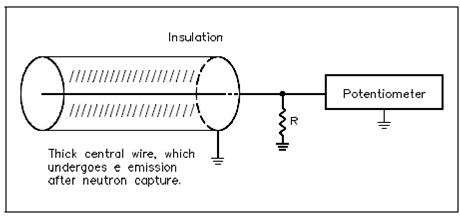Self-Powered Neutron Detector:
In extremely large reactor plants, the requirement exists to monitor neutron flux in several portions of the core on a continuous basis. This permits for quick detection of instability within any section of the core. This requirement brought about the development of the self-powered neutron detector which is small, inexpensive, and rugged sufficient to withstand the in-core environment. The self-powered neutron detector needs no voltage supply for operation. Below figure describes a simplified drawing of a self-powered neutron detector.

Figure: Self-Powered Neutron Detector
The central wire of a self-powered neutron detector is made from a material which absorbs a neutron and undergoes radioactive decay through emitting an electron (beta decay). Classical materials used for the central wire are cadmium, cobalt, vanadium, and rhodium. An excellence insulating material is placed among the central wire and the detector casing. Every time a neutron interacts along with the central wire it transforms one of the wire's atoms into a radioactive nucleus. The nucleus eventually decays through the emission of an electron. Since of the emission of these electrons then the wire becomes more and more positively charged. A positive potential of the wire causes a current to flow in resistor, R. The millivoltmeter measures the voltage drop across the resistor. The electron current from beta decay could also be measured straightly along with an electrometer.
There are two distinct benefits of the self-powered neutron detector: (a) extremely little instrumentation is needed--only a millivoltmeter or an electrometer, and (b) the emitter material has a much greater lifetime than boron or U235 lining (used in huge range fission chambers).
One drawback of the self-powered neutron detector is in which the emitter material decays along with a features half-life. In that case of rhodium and vanadium, that are two of the most meaningful materials, the half-lives are 1 minute and 3.8 minutes, correspondingly. This means that the detector cannot respond instantly to a change in neutron flux, other than takes as long as 3.8 minutes to reach 63 percent of steady-state value. This drawback is overcome through using cobalt or cadmium emitters that emit their electrons inside 10-14 seconds after neutron capture. Self-powered neutron detectors that use cobalt or cadmium are known as prompt self-powered neutron detectors.